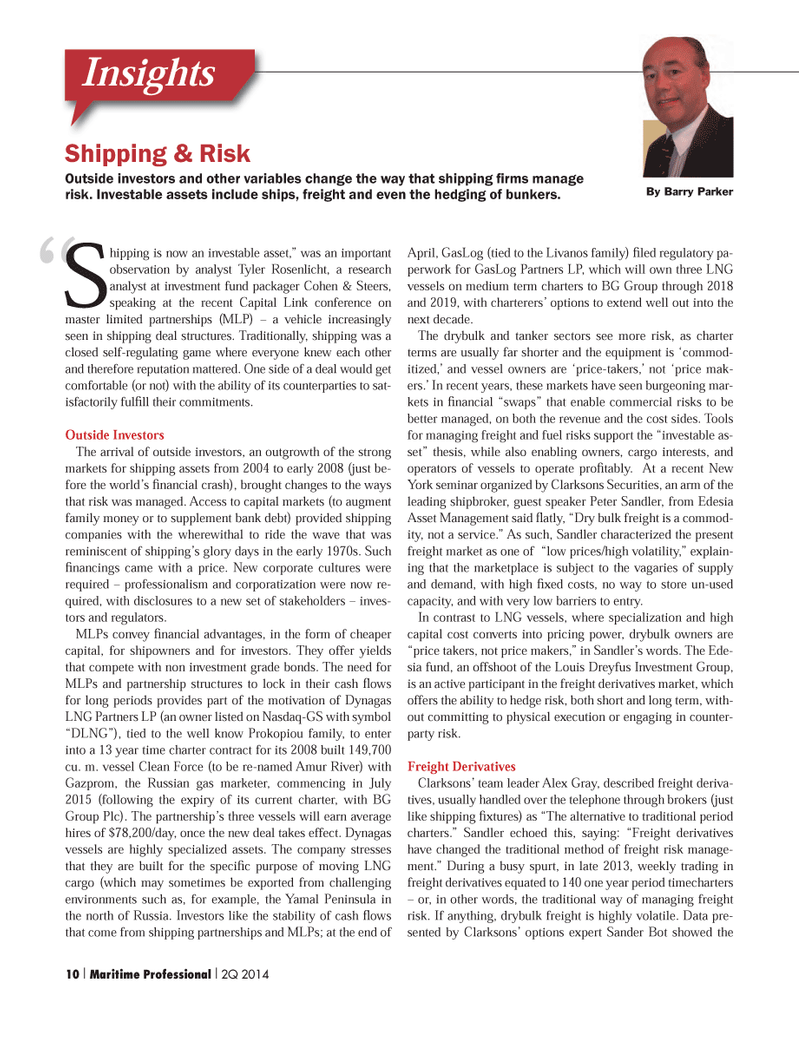
Page 10: of Maritime Logistics Professional Magazine (Q2 2014)
Maritime Risk & Shipping Finance
Read this page in Pdf, Flash or Html5 edition of Q2 2014 Maritime Logistics Professional Magazine
“
Shipping & Risk
Outside investors and other variables change the way that shipping fi rms manage risk. Investable assets include ships, freight and even the hedging of bunkers.
By Barry Parker
Insights
S hipping is now an investable asset,” was an important observation by analyst Tyler Rosenlicht, a research analyst at investment fund packager Cohen & Steers, speaking at the recent Capital Link conference on master limited partnerships (MLP) – a vehicle increasingly seen in shipping deal structures. Traditionally, shipping was a closed self-regulating game where everyone knew each other and therefore reputation mattered. One side of a deal would get comfortable (or not) with the ability of its counterparties to sat- isfactorily fulfi ll their commitments.
Outside Investors
The arrival of outside investors, an outgrowth of the strong markets for shipping assets from 2004 to early 2008 (just be- fore the world’s fi nancial crash), brought changes to the ways that risk was managed. Access to capital markets (to augment family money or to supplement bank debt) provided shipping companies with the wherewithal to ride the wave that was reminiscent of shipping’s glory days in the early 1970s. Such fi nancings came with a price. New corporate cultures were required – professionalism and corporatization were now re- quired, with disclosures to a new set of stakeholders – inves- tors and regulators.
MLPs convey fi nancial advantages, in the form of cheaper capital, for shipowners and for investors. They offer yields that compete with non investment grade bonds. The need for
MLPs and partnership structures to lock in their cash fl ows for long periods provides part of the motivation of Dynagas
LNG Partners LP (an owner listed on Nasdaq-GS with symbol “DLNG”), tied to the well know Prokopiou family, to enter into a 13 year time charter contract for its 2008 built 149,700 cu. m. vessel Clean Force (to be re-named Amur River) with
Gazprom, the Russian gas marketer, commencing in July 2015 (following the expiry of its current charter, with BG
Group Plc). The partnership’s three vessels will earn average hires of $78,200/day, once the new deal takes effect. Dynagas vessels are highly specialized assets. The company stresses that they are built for the specifi c purpose of moving LNG cargo (which may sometimes be exported from challenging environments such as, for example, the Yamal Peninsula in the north of Russia. Investors like the stability of cash fl ows that come from shipping partnerships and MLPs; at the end of
April, GasLog (tied to the Livanos family) fi led regulatory pa- perwork for GasLog Partners LP, which will own three LNG vessels on medium term charters to BG Group through 2018 and 2019, with charterers’ options to extend well out into the next decade.
The drybulk and tanker sectors see more risk, as charter terms are usually far shorter and the equipment is ‘commod- itized,’ and vessel owners are ‘price-takers,’ not ‘price mak- ers.’ In recent years, these markets have seen burgeoning mar- kets in fi nancial “swaps” that enable commercial risks to be better managed, on both the revenue and the cost sides. Tools for managing freight and fuel risks support the “investable as- set” thesis, while also enabling owners, cargo interests, and operators of vessels to operate profi tably. At a recent New
York seminar organized by Clarksons Securities, an arm of the leading shipbroker, guest speaker Peter Sandler, from Edesia
Asset Management said fl atly, “Dry bulk freight is a commod- ity, not a service.” As such, Sandler characterized the present freight market as one of “low prices/high volatility,” explain- ing that the marketplace is subject to the vagaries of supply and demand, with high fi xed costs, no way to store un-used capacity, and with very low barriers to entry.
In contrast to LNG vessels, where specialization and high capital cost converts into pricing power, drybulk owners are “price takers, not price makers,” in Sandler’s words. The Ede- sia fund, an offshoot of the Louis Dreyfus Investment Group, is an active participant in the freight derivatives market, which offers the ability to hedge risk, both short and long term, with- out committing to physical execution or engaging in counter- party risk.
Freight Derivatives
Clarksons’ team leader Alex Gray, described freight deriva- tives, usually handled over the telephone through brokers (just like shipping fi xtures) as “The alternative to traditional period charters.” Sandler echoed this, saying: “Freight derivatives have changed the traditional method of freight risk manage- ment.” During a busy spurt, in late 2013, weekly trading in freight derivatives equated to 140 one year period timecharters – or, in other words, the traditional way of managing freight risk. If anything, drybulk freight is highly volatile. Data pre- sented by Clarksons’ options expert Sander Bot showed the 10 I Maritime Professional I 2Q 2014 1-17 Q2 MP2014.indd 10 5/16/2014 11:41:02 AM

 9
9

 11
11
